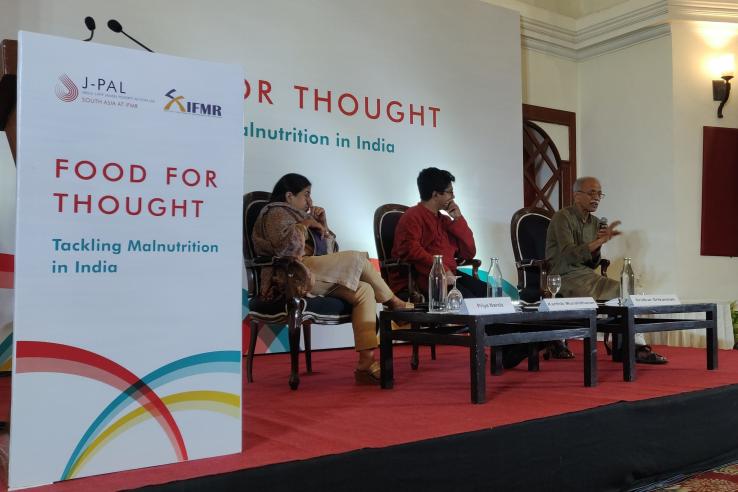India’s nutrition landscape and the path forward

Over the last few years, India has made sizable investments in improving child nutrition through government programs like the Poshan Abhiyaan, the Government of India’s flagship scheme to tackle malnutrition in children, and the ongoing work of the Integrated Child Development Services (ICDS), the world’s largest early childhood development scheme. Despite these investments, malnutrition continues to be a vexing problem for policymakers and researchers alike.
Findings from the recently concluded National Family Health Survey (NFHS)-5 in 2019-20 indicate that a third of India’s children under the age of five are stunted, and a fifth suffer from wasting (defined by the World Health Organization as low-weight-for-height among children), figures that have not changed much in the four years since the previous survey in 2015-16.
While the Covid-19 pandemic may have affected health outcomes during the 2019-20 survey, stagnant child health outcomes remain worrisome given sizable government investments in public health, thereby raising an important question: how can policies and programs be better designed to improve child nutrition in India?
Launched in 2016, J-PAL South Asia’s Cash Transfers for Child Health (CaTCH) Initiative sought to improve child health in India by generating policy-relevant research on a widely proposed approach to this challenge: cash transfers. In 2022, after six years of rigorous, on-the-ground research, insights were presented through a series of events that explored challenges and solutions to urgent public health issues. The final installment in the series dived into various dimensions of the nutrition challenge in India.
The event, titled ‘Food for Thought: Tackling Malnutrition in India,’ brought together industry experts and researchers to discuss strategies to strengthen access to benefits provided under existing cash transfer schemes and tackle capacity constraints in nutrition and health systems. Speakers also explored different modalities of cash transfer schemes, such as supplementing them with “plus” approaches, including providing nutrition information and counseling to parents in addition to cash transfers.
The discussions revealed that existing cash transfer programs are necessary, but not sufficient to improve child nutrition: raising awareness of existing schemes, boosting the personnel of government schemes delivering nutrition services, and buttressing cash transfers with a more holistic, community-level approach towards program design is essential to help underserved groups gain access to nutrition and health systems.
Raising awareness of and easing women’s registration into existing maternity benefit programs
A lack of awareness and complex documentation requirements often act as barriers to the complete utilization of health schemes by potential beneficiaries. Based on surveys with over 300 pregnant women and new mothers in Delhi on their experience accessing Pradhan Mantri Matru Vandana Yojana (PMMVY), India’s flagship maternity benefit scheme, Jessica Leight (International Food Policy Research Institute) found they had low awareness about the scheme, faced high transaction costs during take-up, and lacked the necessary documentation for successful registration. Only a third of all respondents were aware of the scheme and only 13 percent had registered for it.
J-PAL affiliated researcher Simone Schaner (University of Southern California) found similar results in the central Indian state of Chhattisgarh from a study on the take-up of another maternity benefit program, the Janani Suraksha Yojana (JSY): while most women in the sample were aware of the scheme, only a fifth knew the exact monetary benefit it offered. Complex and arduous documentation requirements and high transaction costs at the time of registration also contributed to low enrollment numbers.
Solutions to increasing take-up lie in improving awareness of programs and simplifying the enrollment process. The study in Chhattisgarh evaluated the impact of one such program, ‘Mor Awaaz,’ or greater voice, that involved regularly calling beneficiaries to build their awareness of JSY’s benefits and enrolment procedures. While the program was effective in increasing women’s awareness of JSY, the impact of the phone calls on the take-up of JSY was inconclusive due to sample size limitations.
A range of other solutions were also discussed at the event: Hemang Shah (Children's Investment Fund Foundation) spoke about his experience working on a conditional cash transfer program in Rajasthan that auto-enrolled women to maternity benefit programs, while Anindit Roy Chowdhary (Save the Children India) proposed organizing local camps to aid the registration process.
Augmenting state capacity to delivery nutrition services during early childhood
Existing and new initiatives launched under Poshan Abhiyaan, such as PMMVY and JSY, centre around the key delivery channel of the national ICDS system: anganwadis or rural community centres and their frontline workers. The incorporation of new programs and tasks for already overburdened workers, such as administering Covid-19 vaccinations, leaves them with less time to devote to core services such as providing preschool education and nutritional support to children below the age of six.
J-PAL invited researcher Saravana Ravindran (National University of Singapore) illustrated this by presenting results from data collected on the functioning of ICDS in Odisha during India’s nationwide Covid-19 lockdown, which showed substantial reductions in the provision of preschool services by anganwadi workers.
Another study by Saravana Ravindran and research partners used a randomized evaluation to explore the integration of an early childhood development (ECD) program—involving home visits to provide materials and counseling to parents—into Bangladesh’s flagship nutrition scheme, the National Nutrition Services. The study found evidence that emphasis on ECD improved cognition, language, socio-emotional development, and nutrition outcomes among children as well as led to increased investments by parents in their children’s health. The intervention, however, also led to some displacement of frontline worker effort away from nutrition towards the ECD program.
One potential solution to this challenge involves augmenting the capacity of the ICDS system. J-PAL affiliated researcher Karthik Muralidharan (University of California, San Diego) shared results from a randomized evaluation that tested the impact of adding an extra part-time worker to share the workload in anganwadi centres in Tamil Nadu. The addition doubled worker time spent on educational activities, tripled the time spent on nutrition services, and was also highly cost-effective. Karthik also reflected on how restructuring workflows (with the additional worker in place) had the potential to further improve outcomes.
While solutions to improve the delivery of health services are critical to consider, it is also important to reflect on the quality of health services. On this, Sridhar Srikantiah (CARE India) shared his experiences from CARE India’s Integrated Health and Nutrition Project in Bihar, highlighting the need to address gaps in diet diversity and complementary feeding (additional sources of nutrition beyond breast milk) that persist as limitations of the ICDS despite significant investments in the program.
Moving beyond cash-only programs to improve nutrition outcomes
Cash transfers are a widely proposed solution to improving nutrition outcomes. However, there remain ongoing debates on the modality of the transfer—conditional versus unconditional and food versus cash—alongside key questions on how to time these transfers correctly to improve nutrition outcomes.
Karthik Muralidharan explored some of these questions in a randomized evaluation that provided unconditional cash transfers to pregnant and lactating women in the east Indian state of Jharkhand. Researchers found that the two-year cash transfer program improved nutritional intake and diet diversity among mothers and children, but did not significantly impact children’s height or weight. However, preliminary results showed a correlation between nutrition outcomes and areas with improved sanitation levels, indicating the importance of sanitation in tackling malnutrition.
Global evidence also suggests that combining cash transfers with ‘plus’ components like sanitation, nutrition information, and counseling could help further unlock their potential to improve children’s nutrition outcomes.
Hemang Shah shared how social and behavior change communication (SBCC) tools, such as counseling, community-level meetings, and digital media campaigns, helped promote the use of cash transfers to improve children’s diet diversity in Rajasthan. Similarly, Purnima Menon (International Food Policy Research Institute) spoke about IFPRI’s work in India, Vietnam and Bangladesh, noting that an effective SBCC approach requires understanding the various factors and constraints that influence families’ decisions, such as the double burden women often face in managing work and unpaid care. Private companies have been able to do this successfully, Purnima pointed out, by tapping into the multidimensional burdens women and families face.
The way forward
This event highlighted important demand- and supply-side factors to consider in order to optimize programs aimed at improving nutrition outcomes in India. Insights from the discussions showed that a more holistic, multisectoral approach is essential for tackling the limitations of existing healthcare systems and government programs. Beyond cash-based approaches alone, rigorous research should invest in understanding the community’s needs as a whole as well as the specific needs of mothers and children and the factors influencing their nutrition decisions.
Research that unpacks local problems from this type of holistic lens can help policymakers optimally design and implement programs that tackle the unique challenges faced by individuals in accessing good quality healthcare.


